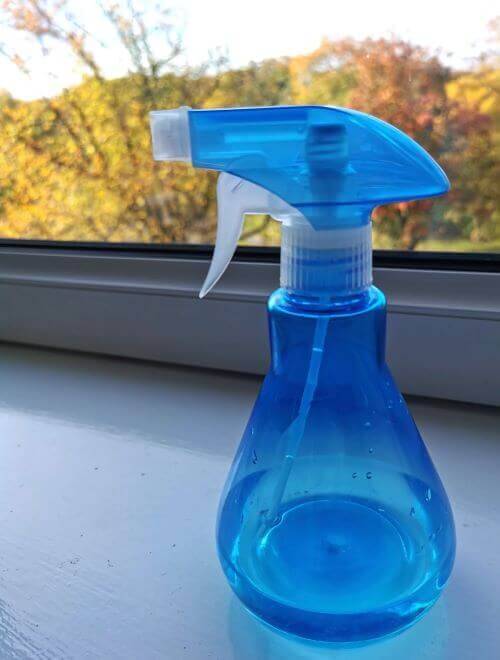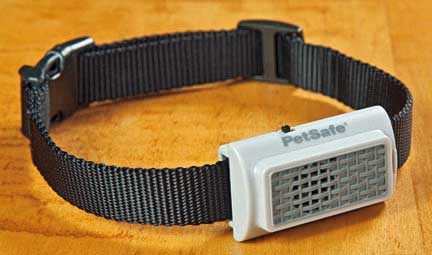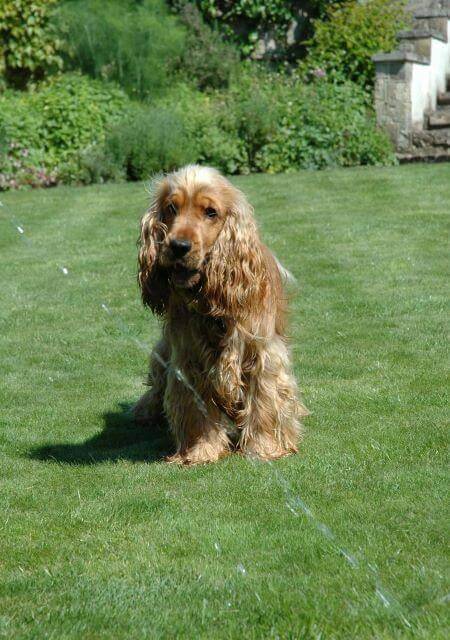- Home
- Cocker Spaniel training
- Dog barking deterrents
Effective Dog Barking Deterrents
There are many barking deterrents on the market; some are better than others. I favour positive training but acknowledge that it's sometimes necessary to use anti barking devices on your dog.
However, I recommend you try other training-based methods first. If you've tried these and still can't stop your dog from barking, read on to learn more about anti-barking devices and how to use them.
How To Stop Your Dog From Barking!
Before I explain effective barking deterrents, I'd like to offer a bit of background about a dog's barking.
When a dog barks, it's because he's got something to say; barking is doggie language. He's trying to tell you something, and unless you're Dr Doolittle, you won't understand a word he says!
The trick to translating this communication is to watch your dog's body language and consider the circumstances surrounding his barking. This will help you to understand what's causing him to bark; he sees an intruder, your dog is hungry, or he's simply attention-seeking.
 If your dog barks for attention, ignore him!
If your dog barks for attention, ignore him!Once you understand why he's barking, you will be able to remove the cause, and your dog will stop barking.
Well, at least that's the theory!
There will be times when you're happy for your dog to bark, for example, if an intruder is snooping around in your garden, but once you've acknowledged your dog's barking, you want him to stop.
If your dog's barking continues or is excessive, it can soon become a real nuisance, not just for your household but for your neighbours too.
There are other ways to stop your dog from barking, and if you've tried them all without success, it may be time to consider barking deterrents.
Types of Barking Deterrents
A Spray Bottle or a Kid's Water Pistol?
Yes, you heard right!
A spray bottle or a child's water pistol makes an excellent dog barking deterrent and can stop dogs from barking in their tracks! Although it may sound cruel to spray your loyal pet with water, it isn't, and more importantly, it won't hurt your dog.
The spray isn't a punishment; it's a barking deterrent to startle your dog into silence, literally interrupting his barking.
 This simple spray bottle can help stop your dog from barking! Who knew?
This simple spray bottle can help stop your dog from barking! Who knew?You can use an ordinary water gun or spray bottle for this method; just fill it with water and do the following:
- Each time your dog barks, use the spray. Squirt a quick spray into your Cocker's mouth or onto your dog's muzzle and say, 'Be Quiet' in a firm but controlled voice.
- When your dog stops barking, wait a few seconds before praising him with the words, 'Good quiet boy', and give him a treat.
- If he begins barking again, re-use the spray immediately.
Do this each time your Cocker Spaniel barks unnecessarily. It will eventually teach your dog to stop nuisance barking.
Points To Note When Using A Spray
When using a spray bottle or a water pistol as a barking deterrent, the following notes will help.
- Some owners swear by a well-diluted mixture of water and lemon juice or water and vinegar, but the choice is yours. Take great care not to spray directly into his eyes, especially if you're using vinegar or lemon juice.
- Trigger the spray the second your dog barks. This will help your dog associate the unpleasant sensation and/or taste of lemon juice or vinegar with your dog's barking. It's basically 'cause and effect'.
- If your garden is enormous, and you can't reach him in time to stop him, don't be tempted to use the spray after he's stopped barking because he probably won't link the two.
He won't understand why you're unhappy with him, and he won't learn anything.
One of the disadvantages of using this type of deterrent is that (as mentioned above) is that you may not always be able to reach your pet in time to give the correction.
Also, if you're not around to hear his barking, you can't give the correction. This will create an inconsistency in training and will hinder any progress.
As an alternative, you could consider fitting your dog with a correction collar which gives an automatic correction.
Compressed Air Works Too!
An air spray also works well as a barking deterrent. No, I didn't say 'hair spray'! It's compressed air in a can, the kind used to clean computer keyboards and cameras.
When released, compressed air emits a loud hiss, interrupting the dog's behaviour.
Compressed air is a pet correction which can be used for many unwanted behaviours, for example, barking, jumping up etc.
Use it each time your dog barks. The sound will startle him into silence, interrupting his behaviour, and you should be able to manage him better.
If you choose to use one of these, follow the instructions carefully and don't aim at your dog's face or eyes. In fact, don't aim at your dog at all.
Barking Deterrent Collars
There are several anti barking collars on the market, and if used properly, they can be very effective barking deterrents.
In training, I always prefer positive reinforcement over negative wherever possible.
However, on occasion, I acknowledge that switching to negative reinforcement tactics may be necessary, especially where all else has failed. Training your dog to stop his excessive barking is one of those occasions.
 An anti barking device to help stop your dog from barking
An anti barking device to help stop your dog from barkingAnti barking collars are worn around the neck, as you may already have deduced (!). The device can be clipped onto your Cocker Spaniel's collar or worn as a separate collar.
These barking deterrents are triggered when a small microphone in the collar picks up the sound of the dog's barking, so you don't need to be around for them to work.
They can also be triggered by a remote control handset that you can activate each time your dog begins to bark. However, the downside to using a handset to start the device is that you must be present when your dog annoys your neighbours with his incessant barking.
Depending on your correction device, it can emit a noise, citronella (lemon juice) or a mild electric pulse each time your Cocker barks.
The momentary 'shock' received from a correction device is usually enough to stop your pet in his tracks. It works by startling your dog and interrupting the flow of his barking.
Once the dog has begun to connect the (unpleasant) correction and his barking, it won't be long before he stops his excessive barking.
When you're confident of this, you can remove the collar altogether.
Lemon/Citronella Barking Deterrent
The device sits against your dog's neck, and the built-in microphone will detect when he's barking.
Once triggered, it gives off a citronella spray at the dog's face.
Although your dog will find the citronella spray unpleasant, I promise you, it won't harm him.
Ultrasound Anti Barking Devices
Ultrasound devices give a short high-pitched sound triggered when your dog starts barking.
The sound is of such a high frequency that humans can't hear it; it's outside our range of hearing. Only your dog will be able to hear it.
Like the other barking deterrents, the noise will startle your dog into becoming quiet. He'll probably look around him and wonder what the sound is and where it's coming from.
Cocker Spaniels have excellent hearing, as you'll probably know if you've ever tried to sneak open a bag of crisps while he's sleeping! You've no chance!
There are two different types of sound-emitting barking deterrents.
They contain microphones that pick up your pet's barking and trigger a sound. One fits onto your dog's collar, and the other can be placed stand-alone in your garden or home.
The stand-alone versions can be set to pick up sounds from several increasing distances.
And don't worry, these devices are perfectly safe; they won't harm your Cocker Spaniel.
One of the benefits of using a barking deterrent collar over the stand-alone version is that the correction is given immediately. An immediate correction will help your Cocker Spaniel to make the 'cause and effect' connection much more quickly.
Electric Barking Deterrents
This barking deterrent emits a mild static electric shock (unlike some harsher, more cruel earlier versions).
The device will have several levels of 'punishment' depending on which brand you buy. It will begin at the lowest setting and gradually increase if your dog fails to stop barking.
They are perfectly safe, and a safety cut-off will kick in after around 45 seconds.
I don't recommend using this kind of barking deterrent on a young puppy; alternative methods exist.
Effective Barking Deterrents: Summary
Anti barking collars are safe if used correctly; you must follow the manufacturer's instructions carefully.
- Don't use the electric shock collars on a puppy; teach him the 'Be Quiet' command.
- Only use these barking deterrents where your dog's barking is excessive.
- If you're using the hand spray, be consistent.
- Never call your Cocker Spaniel to you to spray or punish him.
If you do that, he'll come to believe he's being punished for coming to you, which will confuse him and make him think twice the next time you use the recall command. - Reward your Cocker Spaniel for being quiet. Give him lots of gentle praise when he's lying or playing quietly, and he'll soon realize that calm, quiet behaviour is best for everyone.
- If your Cocker Spaniel is a sensitive little soul, and you think he's frightened of the barking deterrent, please find an alternative method to manage his vocal outbursts.
For example, throw him a ball or his favourite toy to help move his train of thought away from whatever was causing him to bark in the first place.
If your dog receives a 'shock' each time he begins barking, it won't be too long before he realises that this unpleasant sensation stops when he stops barking!
Once he's made this connection, your Cocker Spaniel will think twice about continuing his excessive barking and his vocal outbursts will soon become a thing of the past.
You'll no longer need to use a barking deterrent!
Photo Credits for Barking Deterrents:
1. Visitor photo
2. Copyright of About Cocker Spaniels
3. Copyright of About Cocker Spaniels
4. Origin unknown



